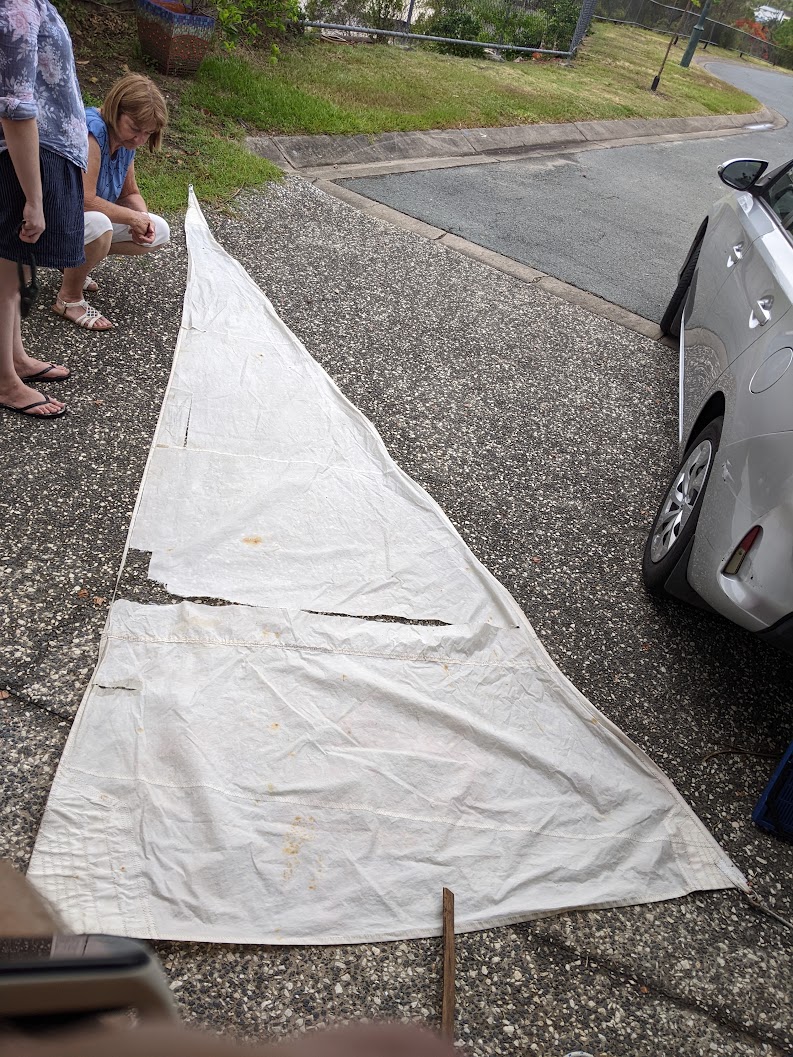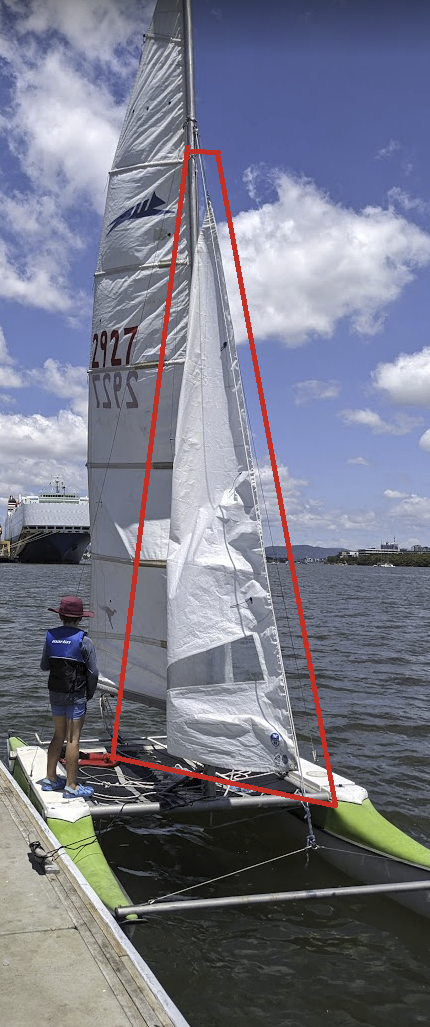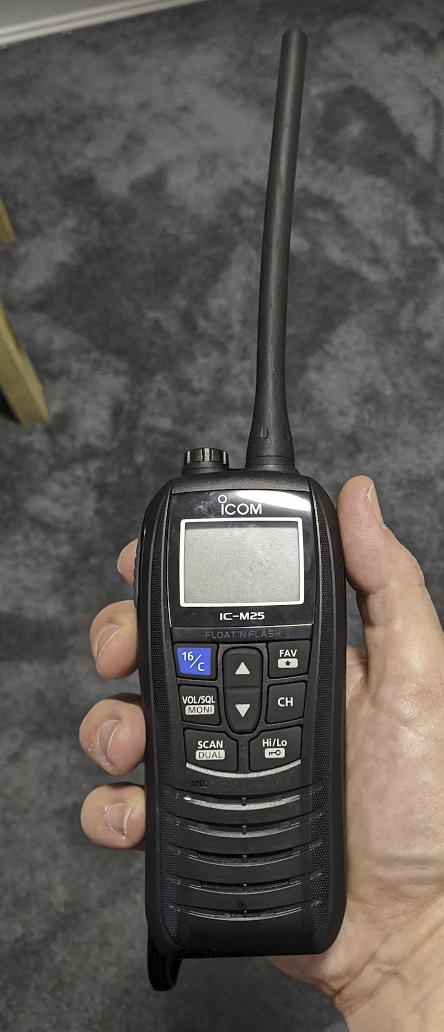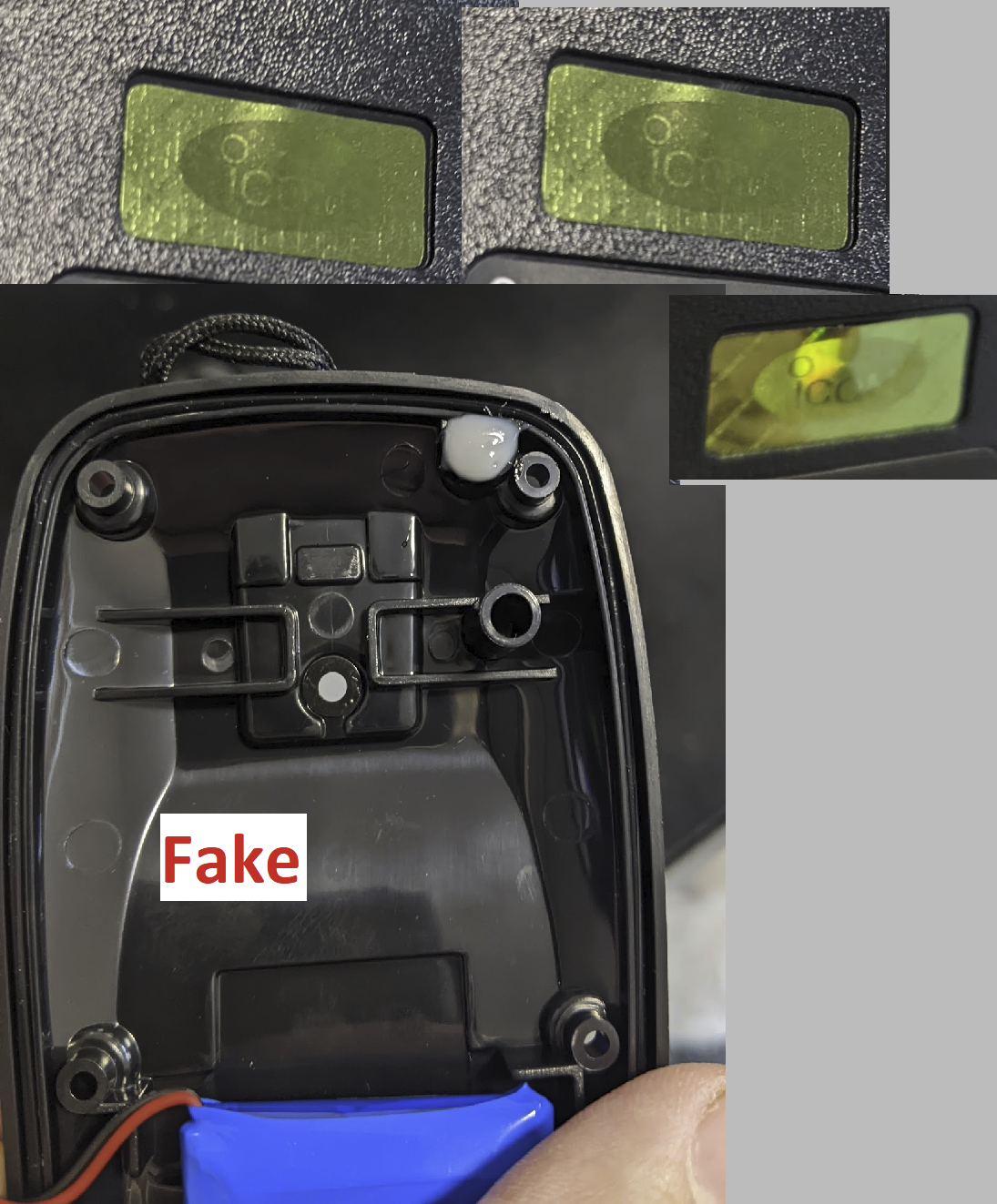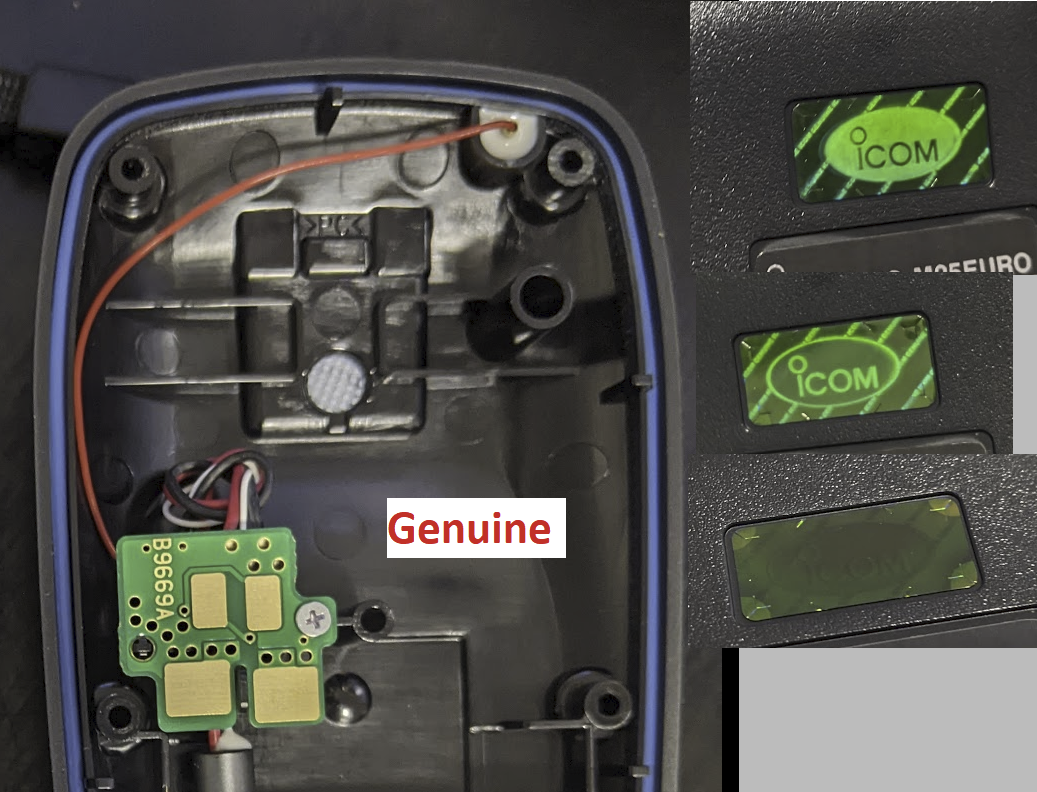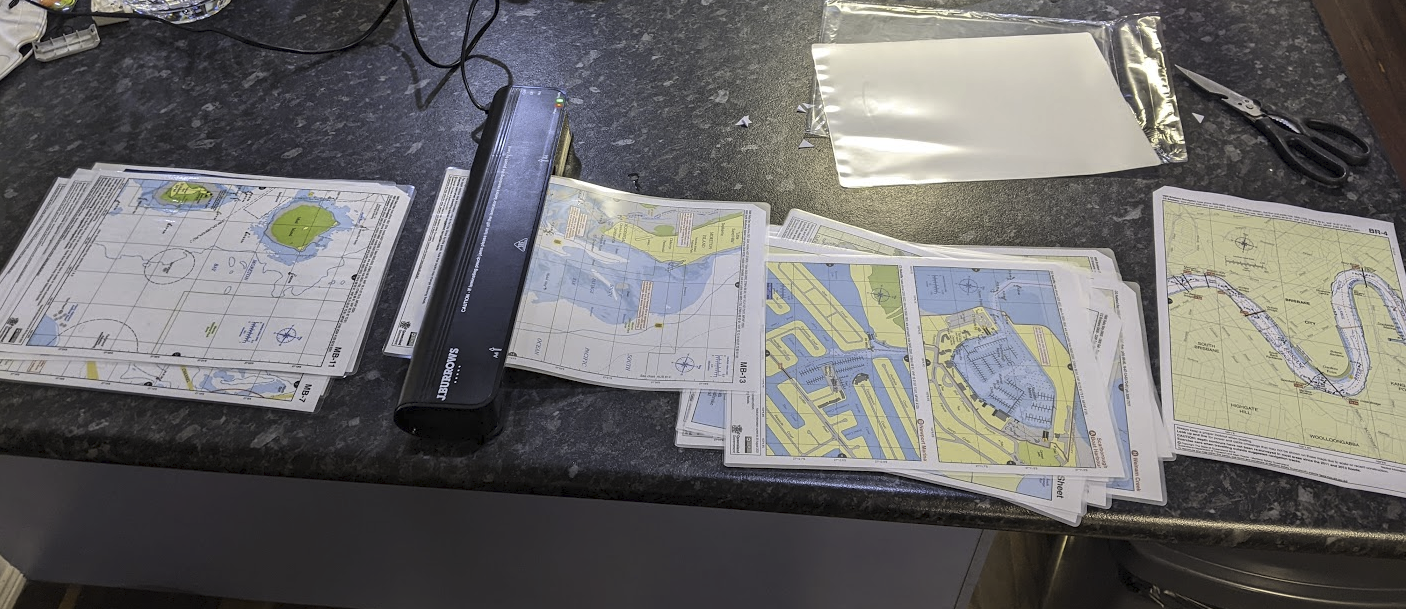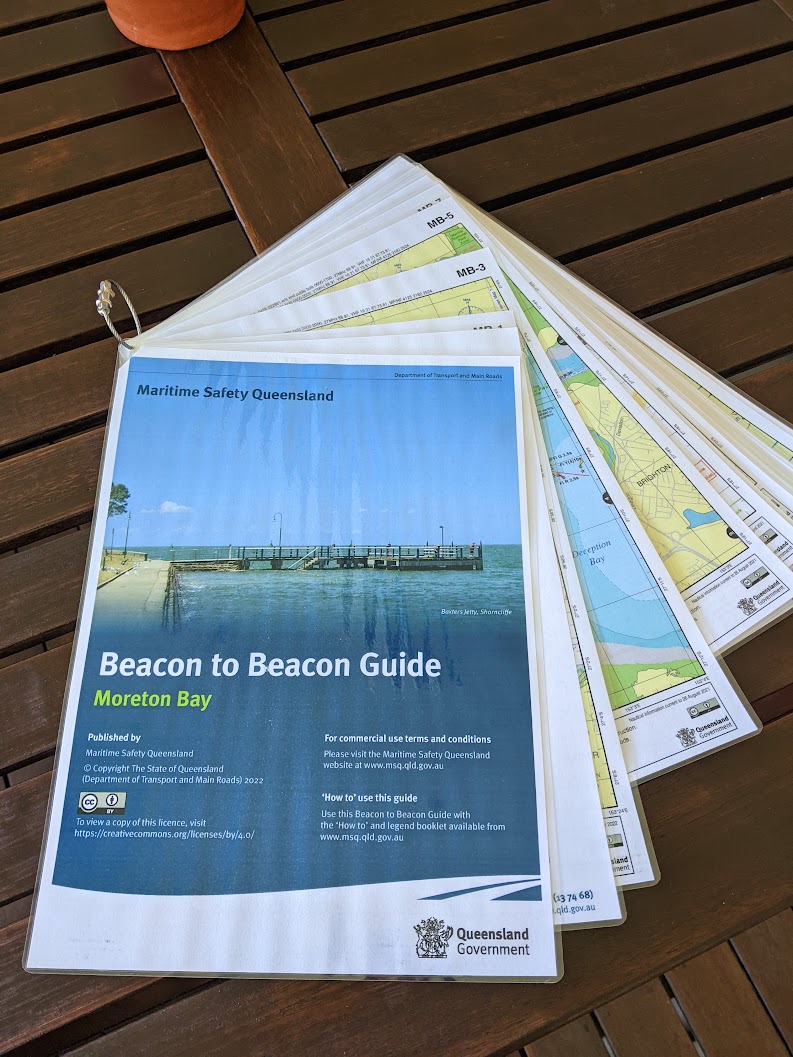Table of Contents
Financial stuff
The “Bring Out Another Thousand” acronym is a well worn warning about the hidden costs of owning a boat. There's always something to improve or fix, so it's easy to spend more than you expect or intend. Our caper cat was in good nick when we bought it, but there were a few things that needed to be done before we could take her out.
I've categorised our boat-related spending into “Fixed to boat” and “Not”. The former (nominally) contribute to the value of the boat and would go away if we sold it. The latter is stuff we'd keep after selling the boat and could re-use if we bought another boat. This categorisation has no real effect but grants me a feeling of control over the process.
New Jib
At the top of the list was the jib. That's the front sail. The original jib was a total wreck. Technically we could sail without a jib but we'd be losing a lot of sail area and we'd have to waste a lot of energy steering with the rudder. The jib and mainsail act to balance each-other to keep the boat going in a straight line. Without the jib we'd need to correct our direction with the rudder constantly, spending our precious wind power to generate turbulent water in our wake. No bueno.
Caper Cats aren't made anymore, so we couldn't buy a replacement off the shelf. Having sails custom-made is expensive, like “more than we paid for the boat” expensive, so I measured some dimensions and found a roughly suitable second hand sail on Sail Exchange. This website lets you search by the various edge lengths, price and quality to find something suitable. The replacement was AUD$200 delivered and arrived in a few days. It was rated 5/10 on the quality scale, but it was in far better condition than any sail I've ever seen.
Our sailing instructor told us that hardcore racing sailors sell their old sails after one or two seasons of sailing. A clapped-out racing sail still makes for an awesome casual pootling sail. I'm not sure if that's where ours came from, but I'm happy with it.
Rigging
Tiresome pedants love to say that sailboats have no ropes, but it's reasonable to ignore them and enjoy a better life as a result. There are ropes everywhere and they all have weird names that predate modern English. Some of these ropes are made of steel. These are collectively called “fixed rigging” and generally don't move much when sailing. These are in contrast to the “running rigging”, which are the ropes you pull on to make the boat go places or stop going places.
I had to install a new luff line along the leading edge of the new jib, and one of the mast shrouds had worn down to a few strands on one end. The shrouds are steel lines that run down the outside of the mast to add stiffness. If a shroud snapped the mast would wonk over sideways like a banana. This is bad for sailing. For this work I would need to pick up a spool of stainless wire, some thimbles, some swages, some shackles, carabiners and a swaging tool. Farewell to another AUD$200-ish.
“Swaging” is a fancy word for “squashing a thick metal tube around a wire”. It's a good way of making a strong join in braided wire. A thimble is an insert that goes inside a loop of wire to enforce a minimum bend radius. The old shroud was close to failure because the thimble was absent; the cable was fatigued by the sharp bend.
 Image source This is not a photo from our boat.
Image source This is not a photo from our boat.
Safety Gear
Life Jackets
We got regular life jackets for the kids, and fancy pull-a-rope-to-inflate life jackets for the adults. They aren't too expensive when you consider what they do. We were looking at them at the shops and Sam (5) asked “This one daddy?” and yanked the inflation cord of a hanging life jacket. Fortunately it just fell off the hook rather than inflating. Kids are great. We got three life jackets for AUD$170 due to a scanning error we didn't notice until we got home. Bonus!
Radio
A marine VHF radio is an important piece of safety gear. If you're heading out into open water you can use it to call in to the Volunteer Marine Rescue folk and let them know the number of people onboard, where you're going and when you expect to be back. This means they can send someone to fish you out if you go missing. It's also handy for calling for help if you need it. I asked a radio nerd mate of mine (thanks VK4BRY!) for some advice. He recommended an ICom radio with at least 5W transmit power. I searched around and found a good price for an ICOM IC-M25 on ebay.
I had a play with the radio when it arrived. It worked fine, but the holographic sticker on the back didn't match the description on ICom's website. My suspicion piqued, I took the back housing off and found the immersion sensor pad wasn't connected to the rest of the radio. Hm. Hmmmmmm.
I requested a refund on ebay and posted it off. At time of writing I haven't received a refund. I ordered another radio from a more reputable storefront for a AUD$50 premium. I had some lingering doubts about my counterfeit assessment of the first one, but these were dispelled by the sticker on the new radio that exactly matched the description. And it had more wires inside, which is usually a good thing.
Charts
Charts (or maps) are important for telling you where things are. You, navigation markers, no-go zones, areas with special rules, boat ramps, water, land, things like that. They also usually show the depth of the water at low tide so you can avoid running aground. This is less of a concern for us because our boat is designed to run aground for fun, but it's a bigger deal for keelboats (boats that poke deep into the water). There are good charting apps for mobile phones, but as a software engineer I have an innate distrust of most software. I decided to go with paper charts. Maritime Safety Queensland publish an excellent set of charts, licensed under creative commons, that are designed to be printed A4. I printed them in double-sided colour at Officeworks and bought a pack of lamination pouches. Bon voyage, AUD$46.30.
I ended up cutting off the fetching swaged stainless wire loop and using a keyring instead. Works much better. I could've bought a pre-made book of charts, but it was slightly more expensive than making it myself, and included a bunch of charts I'd never need.
Everything Else
There were many other odds and sods for various things. The running total is up to AUD$2815.50. Oootch. I hope we use this boat lots.
| Date | Item | Source | Price | Postage | Fixed to boat | Note |
|---|---|---|---|---|---|---|
| 2023-12-16 | Boat | A guy | 1600 | 0 | Yes! | |
| 2023-12-17 | Bunnings | Bunnings | 80 | 0 | Tape, glue, fabric, shackles | |
| 2023-12-18 | Jib | SailExchange | 189 | 15 | Yes | Old jib shagged |
| 2023-12-19 | Radio Icom IC-M25 | Ebay | 180 | 0 | Safety | |
| 2023-12-20 | Tarp and straps | BCF | 156.97 | 0 | Cover boat | |
| 2023-12-20 | Life jackets | BCF | 169.97 | 0 | Charged us for two kid and one adult. | |
| 2023-12-20 | Trailer cable adapter | BCF | 36.99 | 0 | Rectangle to circle | |
| 2023-12-21 | Swages, swager, thimbles | Bunnings | 176.1 | 0 | Shroud repair | |
| 2023-12-21 | Sail repair tape | Ebay | 29.9 | 0 | Jib patch | |
| 2023-12-22 | Rope, shackles, thimbles | Bunnings | 38.8 | 0 | ||
| 2023-12-29 | Glue | Bunnings | 7.99 | 0 | ||
| 2023-12-27 | Charts | Officeworks | 46.3 | Printing and laminating | ||
| 2023-12-29 | Radio Icom IC-M25 | Whitworths | 229 | 32.53 | Other radio counterfeit | |
| 2023-12-29 | Jam cleat | Whitworths | 6.95 | 0 | Yes | |
| 2023-12-29 | Radio refund | Ebay | -180 | Not refunded yet. |
